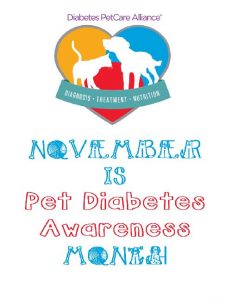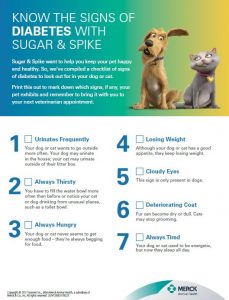 November is National Diabetes Awareness Month. The original purpose was to spread awareness of human diabetes, but since our dogs and cats are at risk too, and the incidence of diabetes in pets continues to climb, it’s important that we, as pet lovers and caretakers, be aware of the signs. Untreated, diabetes can be fatal to your pet. The good news is that in most cases, diabetes is a very manageable disease and most pets with diabetes can continue to live happy, quality lives once their diabetes is under control.
November is National Diabetes Awareness Month. The original purpose was to spread awareness of human diabetes, but since our dogs and cats are at risk too, and the incidence of diabetes in pets continues to climb, it’s important that we, as pet lovers and caretakers, be aware of the signs. Untreated, diabetes can be fatal to your pet. The good news is that in most cases, diabetes is a very manageable disease and most pets with diabetes can continue to live happy, quality lives once their diabetes is under control.
Only a licensed veterinarian can diagnose your pet’s diabetes, but owner awareness is extremely important in bringing attention to any signs the owner may notice at home. Sleeping a lot, weight loss, muscle weakness, cloudy eyes, always thirsty, always hungry – these are just some of the signs to bring to your veterinarian’s attention.
So, what IS diabetes, anyway? Our (and our pet’s) cells need glucose (sugar) to function properly. Our (and our pet’s) pancreas produces insulin. Think of insulin as the key that unlocks the cell so the glucose (sugar) can enter. Diabetes (diabetes mellitus or “DM”) occurs when the body is unable to produce enough insulin on it’s own, which prevents the cells in the body from receiving glucose (sugar). The cells begin to starve and so the body responds by making more glucose (sugar). Since the lack of insulin prevents all of this sugar from entering the cells, the cells continue to starve, and all the excess sugar wreaks havoc through out the body causing the signs and symptoms, and being excreted in the urine. The most common types of Diabetes Mellitus (DM) are Type I and Type II. Type I is most common in dogs and occurs when the body does not make enough insulin and requires lifelong insulin therapy. Type II occurs when the body is making insulin, but it is not enough or there is something else interfering with it’s effectiveness. This type is most common in cats and can often be temporary.
For more information about the types of diabetes, the signs, symptoms and treatments, please visit www.pethealthnetwork.com/dog-health/dog-diseases-conditions-a-z/november-national-pet-diabetes-month
What can YOU do to help YOUR pet? Risk factors include advanced age, breed, genetics, and obesity. Obesity – that’s the one YOU can really help YOUR pet with. Over fifty percent (YES! 50!) of dogs and cats are considered overweight. Why does that matter? Studies show a link between obesity and increased risk of developing diabetes. This happens because as our pets (or ourselves) gain weight, the sensitivity of our tissues to the effects of insulin changes and there is resistance. The body then has to work much harder to produce more insulin – when it can’t produce the amount required, there’s no “key” to open the cells for the glucose (sugar) to enter. Keeping your pet fit and trim is a great way to help them be healthy and happy. Talk to your veterinarian about the proper diet and exercise for your pet.
For more information on the Pet Diabetes Awareness Month, please visit www.petdiabetesmonth.com
If you notice any signs or symptoms in your pet, please contact us to schedule a visit with one of our veterinarians.




